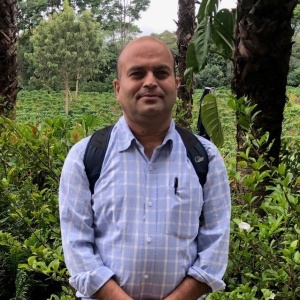Lila Nath Sharma is the team leader of the biodiversity and restoration team at ForestAction Nepal. He leads the REDAA-funded project on ‘Promoting ecologically sound and socially just forest landscape restoration through co-production of knowledge and local capacity building’.
What is your REDAA-supported project trying to achieve?
Our project is trying to achieve three things. First, we want to evaluate the outcomes of past restoration activities in Nepal. We know that Nepal is well-known for restoring forests through participatory approaches and that during the restoration process we have increased our forest cover and tree density. In the early 1990s, for example, forest cover was just 29%. Now we have nearly 40% cover. So we are doing good in terms of forest cover increasing.
But forest degradation persists, forest fires are increasing, as are invasive species – meanwhile forest biodiversity is reducing due to improper restoration strategies, and climate change is also an emerging driver of forest degradation. We are not managing the forest the way it was supposed to be.
What are the invasive species that are degrading forest you mention?
We have mainly three problematic invasive species in the forest. One is called Lantana camara, another is Mikania micrantha, and the third one is Chromolaena odorata. All three have come from South America at different times. Some were introduced and others came unintentionally. So, for example, Lantana was brought to India for gardening, it then spread to Nepal and now it is a wild species and is everywhere in the degraded forests and roadside.
So that's your first goal. You're evaluating what's worked so far. What’s the next task?
Building on the analysis of restoration outcomes, we want to develop strategies that are suitable for different places, different forest types and different climate conditions. This is what we mean by ‘place-based’.
Nepal is very diverse in terms of its geography, climate, forest and forest-people interaction but currently, our restoration programmes are a kind of blanket. A single policy guides restoration throughout the country in relation to different forest types.
We argue that we need very local, fine-scale restoration strategies. Working with communities and government officials, we want to develop very fine scale, place-based strategies that can be applied to different biophysical and socio-cultural contexts.
And the third thing?
The third task is supporting communities and stakeholders in their capacity building and implementing the strategies we will be developing during the project. For example, trainings, workshops, exposure visits, interaction with stakeholders to develop the capacity of different stakeholders like the local communities and Indigenous Peoples who depend on forests for their livelihood.
You separate local communities and Indigenous Peoples. Do they work together or are they separate communities?
It depends. There are mixed communities where people from different ethnic and cultural backgrounds live together, but in other areas it is mainly Indigenous Peoples. Prioritising them means capitalising their traditional ecological knowledge in restoration projects for better outcomes.
In all processes, we will be fully participatory so that our results, methods and strategies will be accepted by different stakeholders. It is a form of co-creation of knowledge in terms of how to develop the strategies and even how to evaluate the past restoration initiative. It's a way experts, stakeholders and local people design the method and the tools together.
How will you decide priority stakeholders in that process? Women, young people, Indigenous Peoples, for example.
Yeah, they are all important – women have higher dependency on the forest and natural resources. Any change in forest condition will affect women of all ages more than others.
What about young people? What do young people do in the area – do they work?
It depends on the households and the location. Some school-going children also need to go to the forest. They need to collect forest products. They need to follow their parents in collecting forest products such as firewood and cattle fodder and wild vegetables, leafy vegetables, mushrooms. People collect many different and even medicinal plants from the forest.
We also try to include people of different ethnicity, different cultural background and different age by engaging with school environment clubs, mothers’ groups, youth clubs and other informal groups. We will include these people in our strategy development and performance evaluation. So they are the part of the capacity building.
Your project points out that sometimes current policies prioritise monocrops. What would those monocrops be?
Our forest management is focused on increasing tree density, forest cover and timber production. In the lowland there is one species called Sal – a tropical species. Sal is highly prioritised in the lower belt of Nepal. And in the mid-hills, timber species, for example pine, are prioritised again. But our forest-people relationship tends to be multi-purpose. People depend on forests for diverse products and services, and we think that our current restoration efforts are not acknowledging that reality.
In addition, Nepal is facing a very fast socio-ecological transition. Many people are migrating from rural areas to urban areas or even abroad. And we are gaining forest cover and that has other consequences. Human-wildlife conflict is increasing, so the new restoration strategies should also think about minimising the conflict and enhancing the co-existence.
What do you think is most special about this REDAA-supported project?
In the past, the restoration analysis has been done using very few or common variables like forest cover and tree density. But we want to make a comprehensive analysis of the past restoration initiative. I think this is a very interesting part of our project.
In addition, we will be using participatory tools, and we are developing very fine-scale locally suitable and adaptable strategies for restoration. That is a particularly exciting thing about the project.
In the current restoration discourse, forest is the top priority. But we will be have broader focus and promote forest landscape restoration rather than just trees and forest.
You must be looking forward to getting to the point where you can roll that out?
Yeah, we definitely are!
